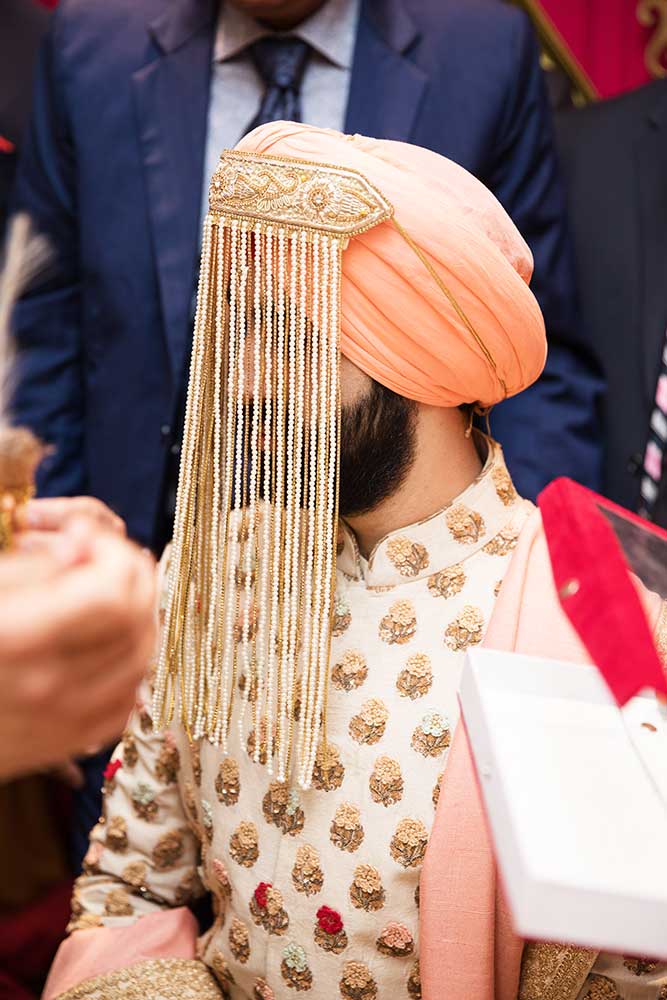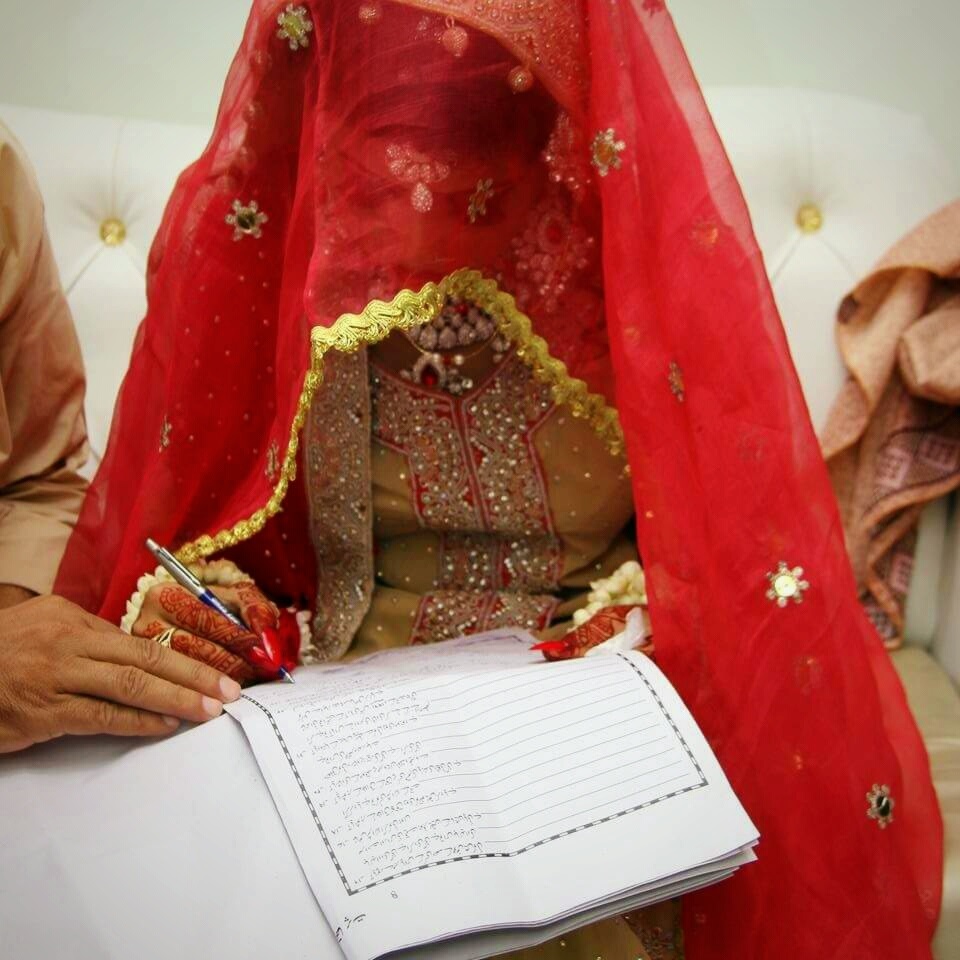|
Sehra (headdress)
A sehra (, Hindi: सेहरा, , ), sehro ( Gujarati: સેહરો), mundavalya (Marathi: मुण्डावळ्या), morrah ( Sindhi: مُوڻ ), or basikam (Telugu: బాసికం) is a forehead garland/nuptial crown worn by the bridegroom (or even bride in some cases) during weddings in Indian subcontinent. This decorative groom’s veil can be made either out of flowers or beads and is tied to the groom’s turban or '' Pagdi''. The sehra has 2 main purposes: They are intended to ward off the evil eye. Secondly, the bride and groom are not supposed to see each other before their wedding ceremony. Therefore, a sehra solved the purpose of hiding the groom’s face, whereas the bride covered her face with a ''ghunghat'' or ''pallu''. They are more prominently worn in North India than in other parts of the country. Etymology The word ''sehra'' is derived from Sanskrit word ''Śīrṣahāra'' (शीर्षहार) meaning garland for decorating head ... [...More Info...] [...Related Items...] OR: [Wikipedia] [Google] [Baidu] |
Hindus
Hindus (; ; also known as Sanātanīs) are people who religiously adhere to Hinduism, also known by its endonym Sanātana Dharma. Jeffery D. Long (2007), A Vision for Hinduism, IB Tauris, , pp. 35–37 Historically, the term has also been used as a geographical, cultural, and later religious identifier for people living in the Indian subcontinent. It is assumed that the term ''"Hindu"'' traces back to Avestan scripture Vendidad which refers to land of seven rivers as Hapta Hendu which itself is a cognate to Sanskrit term ''Sapta Sindhuḥ''. (The term ''Sapta Sindhuḥ'' is mentioned in Rig Veda and refers to a North western Indian region of seven rivers and to India as a whole.) The Greek cognates of the same terms are "''Indus''" (for the river) and "''India''" (for the land of the river). Likewise the Hebrew cognate ''hōd-dū'' refers to India mentioned in Hebrew BibleEsther 1:1. The term "''Hindu''" also implied a geographic, ethnic or cultural identifier for ... [...More Info...] [...Related Items...] OR: [Wikipedia] [Google] [Baidu] |
Marriage In Pakistan
Marriage in Pakistan ( ) pertains to wedding traditions established and adhered by Pakistani men and women in Pakistan, women. Despite their local and regional variations, marriages in Pakistan generally follow Islamic marital jurisprudence. Marriages are not only seen as a union between a husband and a wife, but also an alliance between their respective families. These traditions extend to other countries around in the world where Overseas Pakistani communities exist. Before the wedding Search Searching for a potential groom or bride () is the first step of traditional Pakistani marriages. Beyond age 20, both men and women are considered potential grooms and brides. Most marriages in Pakistan are traditional arranged marriages, semi-arranged marriages or love marriages. *''Arranged marriage'' occurs when a member of the family, a close friend or a third person party helps bring two supposedly compatible people together in matrimony. The groom and bride have usually never met bef ... [...More Info...] [...Related Items...] OR: [Wikipedia] [Google] [Baidu] |
Pakistani Clothing
Pakistani clothing refers to the ethnic clothing that is typically worn by people in the country of Pakistan and by Pakistanis. Pakistani clothes express the culture of Pakistan, the demographics of Pakistan, and cultures from Punjab, Sindh, Balochistan, Khyber Pakhtunkhwa, Gilgit-Baltistan, and Kashmir regions of the country. The clothing in each region and culture of Pakistan reflect weather conditions, way of living, the textiles and embroidery used and its distinctive style which gives it a unique identity among all cultures. Pakistani national dress The Shalwar kameez, Achkan, Sherwani and Kurta shalwar Kameez are the national dresses of Pakistan and is worn by men and women in all five provinces of Punjab, Sindh, Balochistan, Khyber Pakhtunkhwa, and Gilgit-Baltistan in the country and in Azad Kashmir. Shalwar refers to loose trousers and kameez refers to shirts. Since 1982, all officials working in the secretariat are required to wear the national dress. Each province ha ... [...More Info...] [...Related Items...] OR: [Wikipedia] [Google] [Baidu] |
Indian Clothing
Clothing in India varies with the different ethnicities, geography, climate, and cultural traditions of the people of each region of India. Historically, clothing has evolved from simple garments like kaupina, langota, achkan, lungi, sari, to perform rituals and dances. In urban areas, western clothing is common and uniformly worn by people of all social levels. India also has a great diversity in terms of weaves, fibers, colors, and the material of clothing. Sometimes, color codes are followed in clothing based on the religion and ritual concerned. The clothing in India also encompasses a wide variety of Embroidery of India, Indian embroidery, prints, handwork, embellishments, and styles of wearing clothes. A wide mix of Indian traditional clothing and western styles can be seen in India. History File:Mohenjo-daro Priesterkönig.jpeg, Statue of "Priest King" wearing a robe, Indus Valley civilisation. File:Didarganj Yakshi statue in the Bihar Museum.jpg, The Didarganj Yakshi d ... [...More Info...] [...Related Items...] OR: [Wikipedia] [Google] [Baidu] |
Bangladeshi Clothing
The culture of Bangladesh is intertwined with the Culture of Bengal, culture of the ''Bengal region'' of the Indian subcontinent. It has evolved over the centuries and encompasses the cultural diversity of several social groups of Bangladesh. The Bengal Renaissance of the 18th early 19th centuries, noted Bengali Bangladeshi Writers, writers, saints, Bengali literature, authors, scientists, researchers, thinkers, Music of Bengal, music composers, painters, Cinema of Bangladesh, film-makers have played a significant role in the development of Culture of Bengal, Bengali culture. The culture of Bangladesh is deeply intertwined with the culture of the Bengal region. Basically, Culture of Bengal, Bengali culture refers to the culture of Bangladesh. The Bengal Renaissance contained the seeds of a nascent political Indian nationalism which was the precursor in many ways to modern Indian artistic cultural expression. According to M. Nazrul Islam Tamij, a human rights activist and chair ... [...More Info...] [...Related Items...] OR: [Wikipedia] [Google] [Baidu] |
Surdas
Surdas was a 16th-century blind Hindu devotional poet and singing, singer, who was known for his works written in praise of Krishna. His compositions captured his devotion towards Krishna. Most of his poems were written in the Braj language, while some were also written in other dialects of medieval Hindi, like Awadhi. Sūrdās's biography is most often told through the lens of the Vallabha Sampradaya, Vallabha Sampradāya aka the Pushtimarg, Puṣṭimārga. The Puṣṭimārga regards Sūrdās as an initiated disciple of Vallabha, and his hagiography is told in the ''Pushtimarg#Texts, Caurāsī Vaiṣṇavan kī Vārtā'' by Gokulnāth and Harirāy. Sūrdās' poems, along with those of other Aṣṭachāp poets, form a central part of Puṣṭimārga liturgical singing-worship. However modern scholars consider the connection between Sūrdās and Vallabha and his sect to be ahistorical. The book ''Sur Sagar'' (Sur's Ocean) is traditionally attributed to Surdas. However, man ... [...More Info...] [...Related Items...] OR: [Wikipedia] [Google] [Baidu] |
Bhakti
''Bhakti'' (; Pali: ''bhatti'') is a term common in Indian religions which means attachment, fondness for, devotion to, trust, homage, worship, piety, faith, or love.See Monier-Williams, ''Sanskrit Dictionary'', 1899. In Indian religions, it may refer to loving devotion for a personal God (like Krishna or Devi), a formless ultimate reality (like Nirguna Brahman or the Sikh God) or an enlightened being (like a Buddha, a bodhisattva, or a guru).Bhakti ''Encyclopædia Britannica'' (2009)Karen Pechelis (2011), "Bhakti Traditions", in ''The Continuum Companion to Hindu Studies'' (Editors: Jessica Frazier, Gavin Flood), Bloomsbury, , pp. 107–121 Bhakti is often a deeply emotional devotion based on a relationship ... [...More Info...] [...Related Items...] OR: [Wikipedia] [Google] [Baidu] |
Braj Bhasha
Braj is a language within the Indo-Aryan language family spoken in the Braj region in Western Uttar Pradesh centered on Mathura. Along with Awadhi, it was one of the two predominant literary languages of North-Central India before gradually merging and contributing to the development of standardized Hindi in the 19th century. It is spoken today in its unique form in many districts of Western Uttar Pradesh, often referred to as 'Central Braj Bhasha'. The language was historically used for Vaishnavite poetry dedicated to Krishna, whose life was associated with sites in the Braj region. There were also early prose works in terms of the hagiographical ''vārtā'' literature of the Vallabha sect. Braj is considered by scholars to be a more conservative example of the Central Indo-Aryan languages compared to the Hindustani language, which has been influenced by Panjabi and intermediate dialects. Geographical distribution Braj Bhasha is spoken in the nebulous Braj region c ... [...More Info...] [...Related Items...] OR: [Wikipedia] [Google] [Baidu] |
Hindi
Modern Standard Hindi (, ), commonly referred to as Hindi, is the Standard language, standardised variety of the Hindustani language written in the Devanagari script. It is an official language of India, official language of the Government of India, alongside English language, English, and is the ''lingua franca'' of North India. Hindi is considered a Sanskritisation (linguistics), Sanskritised Register (sociolinguistics), register of Hindustani. Hindustani itself developed from Old Hindi and was spoken in Delhi and neighbouring areas. It incorporated a significant number of Persian language, Persian loanwords. Hindi is an Languages with official status in India, official language in twelve states (Bihar, Gujarat , Mizoram , Maharashtra ,Chhattisgarh, Haryana, Himachal Pradesh, Jharkhand, Madhya Pradesh, Rajasthan, Uttar Pradesh, Uttarakhand), and six Union territory, union territories (Andaman and Nicobar Islands, Delhi, Chandigarh, Dadra and Nagar Haveli and Daman and Di ... [...More Info...] [...Related Items...] OR: [Wikipedia] [Google] [Baidu] |
Sanskrit
Sanskrit (; stem form ; nominal singular , ,) is a classical language belonging to the Indo-Aryan languages, Indo-Aryan branch of the Indo-European languages. It arose in northwest South Asia after its predecessor languages had Trans-cultural diffusion, diffused there from the northwest in the late Bronze Age#South Asia, Bronze Age. Sanskrit is the sacred language of Hinduism, the language of classical Hindu philosophy, and of historical texts of Buddhism and Jainism. It was a lingua franca, link language in ancient and medieval South Asia, and upon transmission of Hindu and Buddhist culture to Southeast Asia, East Asia and Central Asia in the early medieval era, it became a language of religion and high culture, and of the political elites in some of these regions. As a result, Sanskrit had a lasting effect on the languages of South Asia, Southeast Asia and East Asia, especially in their formal and learned vocabularies. Sanskrit generally connotes several Indo-Aryan languages# ... [...More Info...] [...Related Items...] OR: [Wikipedia] [Google] [Baidu] |
Pagri
Phari or Pagri (; ) is a town in Yadong County in the Tibet Autonomous Region, China near the border with Bhutan. The border can be accessed through a secret road/trail connecting Tsento Gewog in Bhutan () known as Tremo La. the town had a population of 2,121. It is one of the highest towns in the world, being about above sea-level at the head of the Chumbi Valley. History Thomas Manning, the first Englishman to reach Lhasa, visited Pagri from 21September until 5November 1811 and had this to say about his room in the town: "Dirt, dirt, grease, smoke. Misery, but good mutton." The Pagri Fortress (''Dzong'') was located here and was important for the government as it stood between Tibet and Bhutan. Pagri was a staging area en route to Gyantse and ultimately Lhasa. Thubten Ngodup, the current Nechung Oracle, was born in Phari in 1957. Gallery File:Bundesarchiv Bild 135-S-06-06-22, Tibetexpedition, Blick auf Phari Dzong.jpg File:Phari Dzong in 1903.jpg, Phari Dzong in 1903 ... [...More Info...] [...Related Items...] OR: [Wikipedia] [Google] [Baidu] |






